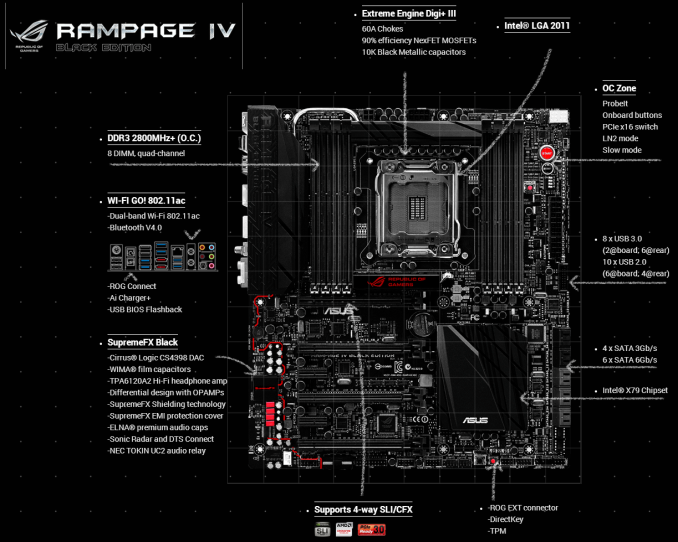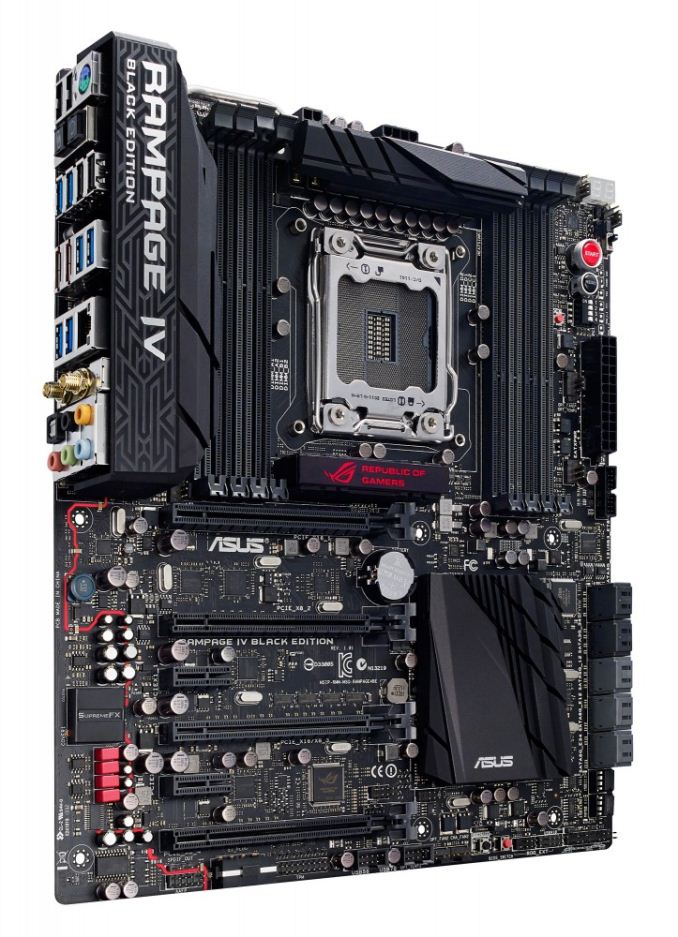ASUS Rampage IV Black Edition Review
by Ian Cutress on January 5, 2014 10:00 AM EST- Posted in
- Motherboards
- Intel
- Asus
- X79
ASUS Rampage IV Black Edition Conclusion
High end products position themselves in a precarious place – they have to live up to their price point, but also not price themselves out of the market. When dealing with the X79 platform, where the six core processors cost $560-$999, price can still be an issue. The Rampage IV Black Edition is more expensive than the Rampage IV Extreme – moving from a $450 to a $500 price point. That equates the motherboard to almost the same price as the i7-4930K processor: this regime is not unheard of in the mainstream Z87 platform, where motherboards can easily out-price the i7-4770K. So when a user makes the jump to X79, it might not only be the expense of the CPU to be taken into account – ASUS has done well in making the RIVE one of the bestselling motherboards of X79.
Aside from the color scheme, the Rampage IV Black Edition brings some of the Z87 platform enhancements that ASUS has been working on to the antiquated X79 ecosystem. Some of the ones that get the most attention is the SSD Secure Erase feature in the BIOS and the updated BIOS itself, allowing for a My Favorites menu for extreme overclockers to easily adjust their overclock settings. Another big feature is the OC Panel, providing overclockers with adjustments on the fly as well as moving some features off the motherboard (VGA Hotwire, Sub-zero Sense, Slow Mode/Pause buttons) and as a direct result increasing POST time into older operating systems. The OC Panel works with the Z87 ROG range as well.
The motherboard is also filled to the brim with USB 3.0 ports (eight) and SATA ports (ten, four SATA 6 Gbps) due to additional controllers, and one additional feature I like on motherboards is the included 802.11ac WiFi. Given that this last feature is now on some $150 motherboards, the only restriction to having it on the high end products is implementation and routing. ASUS also equip the motherboard with their SupremeFX audio setup, although to be honest it did not perform well in our test as hoped. The motherboard might also be considered lacking in some areas (Thunderbolt, dual Intel NIC) for users with specific needs – there are other products on the market to cater for these prosumers.
There are two main issues ASUS will have to contend with in terms of the RIVBE, one of which they have no control over: the appeal of Ivy Bridge-E. Users who migrated to Sandy Bridge-E have done so already, so one could argue that upgrading the motherboard is not necessarily a regular thing to do unless the original is limiting. Users who waited for Ivy Bridge-E might not have been impressed by the performance gain and choose to wait until Haswell-E. The chipset is also a factor – X79 is now old and a certain part of me wonders why Intel did not release an X89 update with full SATA 6 Gbps/native USB 3.0 while still keeping the chipset. The last factor, as mentioned already, is pricing. The ASUS Rampage IV Black Edition is certainly in the prosumer bracket, and users saving for a six-core processor might have to fall back on cheaper motherboards to implement their CPU choice.
Performance wise, the Black Edition performs as well as any other MultiCore Turbo enabled motherboard on the market at stock speeds, and it took our DDR3-2400 C10 memory kit in its stride. The automatic overclock in the OS was a little underwhelming, although there are plenty of overclock options in the BIOS to get your teeth into. No other motherboard manufacturer plays in this high end space (Extreme11 being a technological showcase), and for users with the budget, it is the board that should keep you going – until the next socket change at least, and the Rampage V series.












21 Comments
View All Comments
JlHADJOE - Sunday, January 5, 2014 - link
Wait, so the Auto-OC actually beat your manual OC results? Impressive!The table says Auto-OC managed to get 47/47/46/46/45/45 stable where your manual OC maxed out at 45, and it also got 45x100 stable at less volts and lower temps than manual.
Razorbak86 - Sunday, January 5, 2014 - link
The PovRay score for the 45x100 manual OC was higher, the voltage was lower, and the OCCT temp was lower. I'd say the 4.5GHz manual OC beat the Auto-OC hands down.JlHADJOE - Monday, January 6, 2014 - link
Auto OC: 45x100, 1.400V BIOS, 1.408V load, 77CManual OC: 45x100, 1.425V BIOS, 1.440V load, 80C
Slightly higher Povray is probably just variance, or down to something other than the CPU (perhaps XMP timings). I'd say the Auto-OC was better.
IanCutress - Sunday, January 5, 2014 - link
For the manual OC I only adjust the voltage, CPU multiplier and the CPU load line calibration, which is pretty much what most users will do when manually overclocking unless told otherwise (or there's another setting you must adjust). It's clear the Auto-OC does a bit more under the hood (VCCSA/VSSIO voltages most likely) - at the expense of a higher voltage (to catch more processors). In my test, I also only focus on all cores the same speed, and the stress test attacks all cores, rather than single cores that might be higher turboed. There is scope to go playing around with all the settings, which is what the ROG forums are there to do for users who have only one motherboard every couple of years to organise :)jasonelmore - Sunday, January 5, 2014 - link
I've found that disabling the C States of power saving features such as speed step has drastically improved my max overclock on the Rampage IV Extereme BESamus - Sunday, January 5, 2014 - link
$500!? yeooow.Gen-An - Sunday, January 5, 2014 - link
Ian,Have you seen any noticeable difference in memory OC using the Black Edition vs the original RIVE with the same CPU and RAM? People on various forums are saying the BE is more optimized for IB-E and memory OC, but I haven't been able to find anything definitive to support that statement.
jigglywiggly - Sunday, January 5, 2014 - link
why's the first picture skewed lol?great review as always ;D
IanCutress - Sunday, January 5, 2014 - link
I haven't stressed the RIVE with Ivy-E and high (2800+) memory yet, although this motherboard was designed with Ivy Bridge-E as the focus after ASUS finished the Maximus VI range. So if there are optimisations for Ivy-E above the RIVE that are more than just BIOS, the RIVBE should have them. So while I don't have any data, I expect that would be the case. Now whether faster memory is actually useful for a given workload is a different matter...Gen-An - Wednesday, January 8, 2014 - link
Just interested for the OC fun factor, 24/7 I run DDR3-2400 C9.